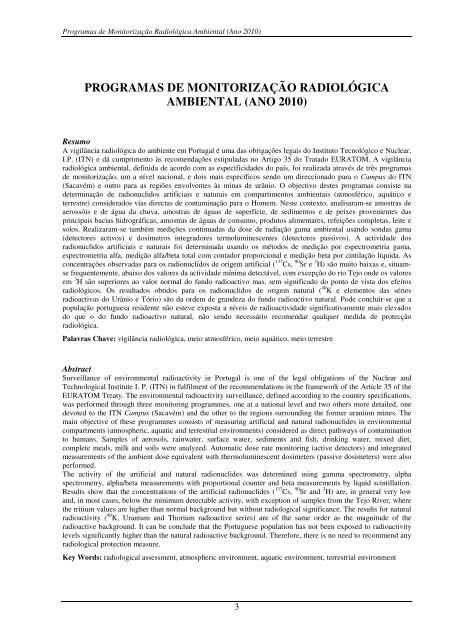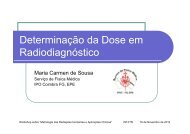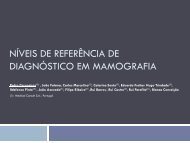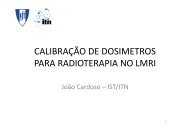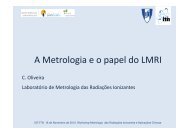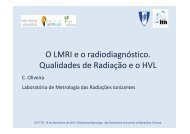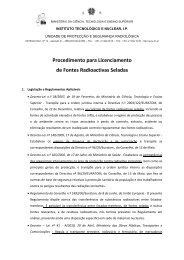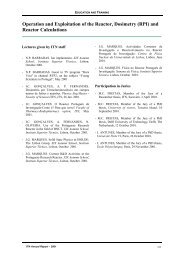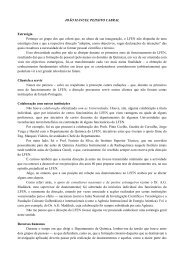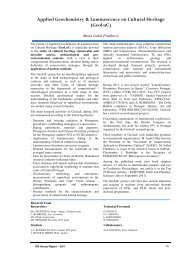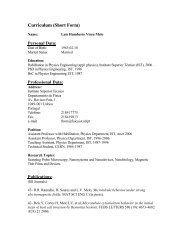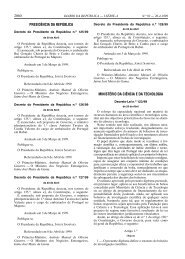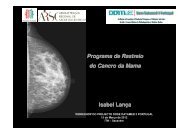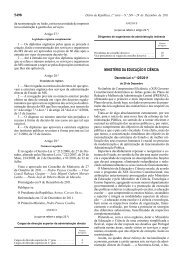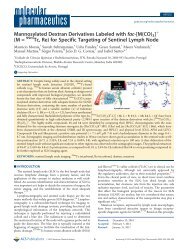Programas de Monitorização Radiológica Ambiental - Instituto ...
Programas de Monitorização Radiológica Ambiental - Instituto ...
Programas de Monitorização Radiológica Ambiental - Instituto ...
You also want an ePaper? Increase the reach of your titles
YUMPU automatically turns print PDFs into web optimized ePapers that Google loves.
<strong>Programas</strong> <strong>de</strong> Monitorização Radiológica <strong>Ambiental</strong> (Ano 2010)<br />
PROGRAMAS DE MONITORIZAÇÃO RADIOLÓGICA<br />
AMBIENTAL (ANO 2010)<br />
Resumo<br />
A vigilância radiológica do ambiente em Portugal é uma das obrigações legais do <strong>Instituto</strong> Tecnológico e Nuclear,<br />
I.P. (ITN) e dá cumprimento às recomendações estipuladas no Artigo 35 do Tratado EURATOM. A vigilância<br />
radiológica ambiental, <strong>de</strong>finida <strong>de</strong> acordo com as especificida<strong>de</strong>s do país, foi realizada através <strong>de</strong> três programas<br />
<strong>de</strong> monitorização, um a nível nacional, e dois mais específicos sendo um direccionado para o Campus do ITN<br />
(Sacavém) e outro para as regiões envolventes às minas <strong>de</strong> urânio. O objectivo <strong>de</strong>stes programas consiste na<br />
<strong>de</strong>terminação <strong>de</strong> radionuclidos artificiais e naturais em compartimentos ambientais (atmosférico, aquático e<br />
terrestre) consi<strong>de</strong>rados vias directas <strong>de</strong> contaminação para o Homem. Neste contexto, analisaram-se amostras <strong>de</strong><br />
aerossóis e <strong>de</strong> água da chuva, amostras <strong>de</strong> águas <strong>de</strong> superfície, <strong>de</strong> sedimentos e <strong>de</strong> peixes provenientes das<br />
principais bacias hidrográficas, amostras <strong>de</strong> águas <strong>de</strong> consumo, produtos alimentares, refeições completas, leite e<br />
solos. Realizaram-se também medições continuadas da dose <strong>de</strong> radiação gama ambiental usando sondas gama<br />
(<strong>de</strong>tectores activos) e dosimetros integradores termoluminescentes (<strong>de</strong>tectores passivos). A activida<strong>de</strong> dos<br />
radionuclidos artificiais e naturais foi <strong>de</strong>terminada usando os métodos <strong>de</strong> medição por espectrometria gama,<br />
espectrometria alfa, medição alfa/beta total com contador proporcional e medição beta por cintilação líquida. As<br />
concentrações observadas para os radionuclidos <strong>de</strong> origem artificial ( 137 Cs, 90 Sr e 3 H) são muito baixas e, situamse<br />
frequentemente, abaixo dos valores da activida<strong>de</strong> mínima <strong>de</strong>tectável, com excepção do rio Tejo on<strong>de</strong> os valores<br />
em 3 H são superiores ao valor normal do fundo radioactivo mas, sem significado do ponto <strong>de</strong> vista dos efeitos<br />
radiológicos. Os resultados obtidos para os radionuclidos <strong>de</strong> origem natural ( 40 K e elementos das séries<br />
radioactivas do Urânio e Tório) são da or<strong>de</strong>m <strong>de</strong> gran<strong>de</strong>za do fundo radioactivo natural. Po<strong>de</strong> concluir-se que a<br />
população portuguesa resi<strong>de</strong>nte não esteve exposta a níveis <strong>de</strong> radioactivida<strong>de</strong> significativamente mais elevados<br />
do que o do fundo radioactivo natural, não sendo necessário recomendar qualquer medida <strong>de</strong> protecção<br />
radiológica.<br />
Palavras Chave: vigilância radiológica, meio atmosférico, meio aquático, meio terrestre<br />
Abstract<br />
Surveillance of environmental radioactivity in Portugal is one of the legal obligations of the Nuclear and<br />
Technological Institute I. P. (ITN) in fulfilment of the recommendations in the framework of the Article 35 of the<br />
EURATOM Treaty. The environmental radioactivity surveillance, <strong>de</strong>fined according to the country specifications,<br />
was performed through three monitoring programmes, one at a national level and two others more <strong>de</strong>tailed, one<br />
<strong>de</strong>voted to the ITN Campus (Sacavém) and the other to the regions surrounding the former uranium mines. The<br />
main objective of these programmes consists of measuring artificial and natural radionucli<strong>de</strong>s in environmental<br />
compartments (atmospheric, aquatic and terrestrial environments) consi<strong>de</strong>red as direct pathways of contamination<br />
to humans. Samples of aerosols, rainwater, surface water, sediments and fish, drinking water, mixed diet,<br />
complete meals, milk and soils were analyzed. Automatic dose rate monitoring (active <strong>de</strong>tectors) and integrated<br />
measurements of the ambient dose equivalent with thermoluminescent dosimeters (passive dosimeters) were also<br />
performed.<br />
The activity of the artificial and natural radionucli<strong>de</strong>s was <strong>de</strong>termined using gamma spectrometry, alpha<br />
spectrometry, alpha/beta measurements with proportional counter and beta measurements by liquid scintillation.<br />
Results show that the concentrations of the artificial radionucli<strong>de</strong>s ( 137 Cs, 90 Sr and 3 H) are, in general very low<br />
and, in most cases, below the minimum <strong>de</strong>tectable activity, with exception of samples from the Tejo River, where<br />
the tritium values are higher than normal background but without radiological significance. The results for natural<br />
radioactivity ( 40 K, Uranium and Thorium radioactive series) are of the same or<strong>de</strong>r as the magnitu<strong>de</strong> of the<br />
radioactive background. It can be conclu<strong>de</strong> that the Portuguese population has not been exposed to radioactivity<br />
levels significantly higher than the natural radioactive background. Therefore, there is no need to recommend any<br />
radiological protection measure.<br />
Key Words: radiological assessment, atmospheric environment, aquatic environment, terrestrial environment<br />
3


